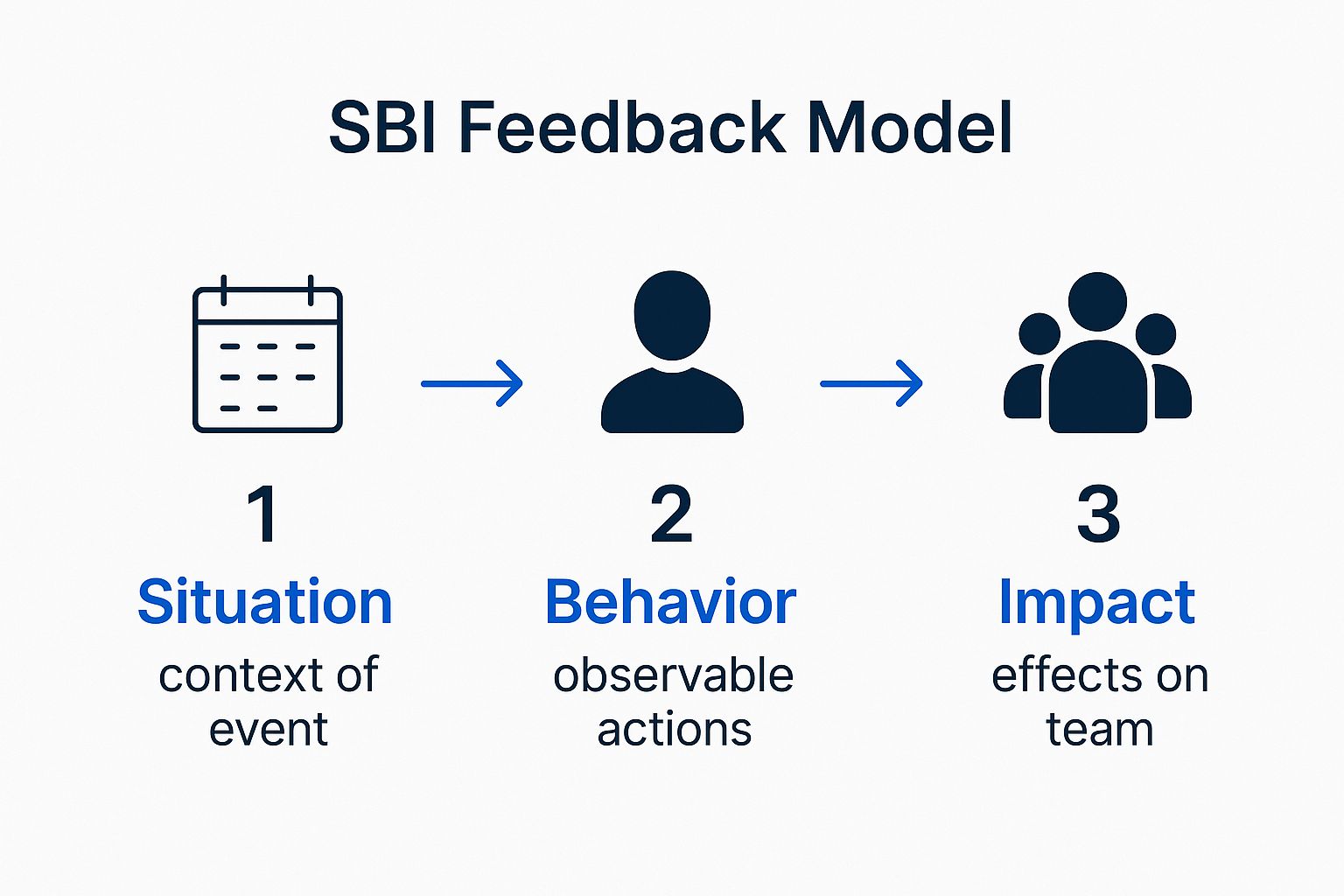Giving constructive feedback is a real skill. It's about carefully preparing what you're going to say, zeroing in on specific behaviours rather than personality traits, and working together to map out a clear path forward. Think of it as opening a dialogue for growth, not delivering a monologue of criticism. Your role is to be a supportive coach, not a harsh critic.
Why Most Feedback Fails and How to Fix It
Let's be real—giving feedback often feels incredibly awkward for everyone involved. Too many of these conversations just miss the mark entirely, turning what should be a moment of growth into a tense confrontation. This usually happens when we forget the human element, getting so caught up in the problem that we lose sight of the person and the context surrounding the situation.

Often, the root issue is a simple gap between what we intend and how we deliver it. A manager might genuinely want to be helpful, but if their feedback is vague, poorly timed, or comes across without a shred of empathy, it can easily feel like a personal attack. That’s when the walls go up, communication shuts down, and morale takes a nosedive.
The Expectation Mismatch
In the UK, there's a huge disconnect between how often employees want feedback and how often they actually get it. While nearly half of all managers are convinced they give feedback regularly, only about 20% of employees say they receive it weekly. That’s a massive gap. One-third of UK employees are left waiting over three months for any kind of input from their manager, which is a real motivation killer. Often, these issues are a symptom of a wider problem; learning how to improve team collaboration can help build a foundation of better communication.
This desire for more guidance is especially strong among younger generations.
- Gen Z: A huge 63% say they want timely, consistent feedback.
- Millennials: Over half are looking for constant input to help steer their development.
The message here is crystal clear: your team, especially its younger members, is crying out for guidance. They don't view feedback as a negative thing; they see it as a vital tool for getting ahead in their careers.
The most effective feedback isn't a dreaded annual review; it's a continuous conversation. When you weave it into your day-to-day culture, you strip away the fear and anxiety that so often comes with it.
Reframing the Conversation
If we want to fix our broken feedback loops, we have to start thinking about it differently. It's time to stop seeing feedback as a difficult chore and start seeing it for what it is: a powerful, strategic tool for building alignment and engagement. When you get it right, it fosters psychological safety and empowers people to take the reins of their own professional growth.
The aim should be to move away from top-down directives and towards a collaborative partnership. It's no accident that highly engaged employees are more than twice as likely to get weekly feedback as their disengaged colleagues. Consistent, thoughtful feedback is proof that you're invested in your team's success. That investment builds loyalty, drives performance, and ultimately creates a much stronger, more resilient organisation.
How to Prepare for a Feedback Conversation
A genuinely effective feedback conversation starts long before you ever sit down to talk. I’ve seen it time and again: the most impactful discussions are those built on a solid foundation of thoughtful preparation. It’s what turns a potentially tense meeting into a real opportunity for growth. Simply jumping in without a plan is just asking for a vague, emotional, or completely unproductive exchange.

The very first thing to do is a mental reset. You need to shift your mindset from being a critic to being a coach. Your goal here isn't to point out flaws; it's to help someone get better. When you approach the conversation with positive intent and a genuine focus on development, the entire dynamic changes, making the other person far more open to what you have to say.
Gather Specific Examples
Let’s be honest: vague feedback is useless. Saying things like "you need to be more proactive" or "your communication is lacking" leaves people confused and without a clear path forward. This is why your preparation has to centre on gathering concrete, observable examples of the behaviour you want to discuss.
- Instead of: "You've been dropping the ball on project updates."
- Try this: "In Tuesday's team meeting, when asked for an update on the Q3 report, you mentioned you hadn't started. The knock-on effect was that we couldn't give the client a clear timeline."
This kind of specificity takes personal judgement out of the equation and puts the focus squarely on the action and its consequences. The more you can ground your feedback in actual events, the clearer and more objective it becomes. Honing these observational skills is a core part of effective leadership and is often a focus in communication skills training for employees.
Great feedback is about observable behaviour, not subjective opinion. Focus on what you saw or heard and the direct impact it had. This simple shift moves the conversation from accusation to observation.
Define Your Core Message and Timing
Before you even think about booking a room, you should be able to state the single, most important message you want to deliver in one clear sentence. If you try to cover too much ground at once, you’ll just overwhelm the other person and your main point will get lost in the noise. Pick one key area for improvement and stick to it.
With your message crystal clear, it’s time to think about the logistics. Privacy is non-negotiable. Feedback should always be given one-on-one to show respect and create a safe space for an honest chat. The timing is just as crucial. Avoid springing feedback on someone when either of you is stressed, rushed, or emotional. Find a neutral time when you can both be fully present and ready for a productive dialogue. This groundwork sets the stage for a conversation that builds people up, rather than tearing them down.
Choosing the Right Framework for Your Feedback
Trying to deliver feedback without a clear structure is a bit like trying to build flat-pack furniture without the instructions. You might get there in the end, but it’s going to be a messy, frustrating experience for everyone involved. A solid framework gives you a simple, repeatable roadmap for the conversation, helping you stay on track and ensuring your message actually lands.
When you just "wing it," it's easy for personal opinions and emotions to creep in. Leaning on a proven model helps strip that away. This focus on objective facts is the key, as it dramatically lowers the other person's natural defensiveness. When you present feedback as a neutral observation, it becomes a problem to solve together, not a personal attack.
The Power of SBI: Situation-Behaviour-Impact
One of the most effective and straightforward models I've come across is Situation-Behaviour-Impact (SBI). It's brilliant in its simplicity and works just as well for giving praise as it does for offering guidance. The whole point is to describe what happened without a hint of judgement.
This infographic lays out the simple, logical flow of the SBI model.

As you can see, the model moves from a specific context to an observable action and then to its tangible outcome. This creates a clear and logical story that's easy to follow.
Let's put it into practice. Imagine a team member consistently interrupts others during virtual meetings.
- Situation: "This morning, during the project kick-off call with the new client..."
- Behaviour: "...I noticed you spoke over Sarah a couple of times while she was sharing her initial ideas."
- Impact: "...The impact was that we didn't get to hear her full thoughts, and the client seemed a little unsure of who was leading that part of the discussion."
See how non-confrontational that is? You're not saying, "You're a rude interrupter." You're stating a specific event and its direct consequence. This makes it far easier for the person to hear the feedback and realise why a change in behaviour is needed.
When to Use the STAR Method
Another excellent tool, especially for performance-related chats, is the STAR method. It's quite similar to SBI but adds a crucial fourth element: action. This makes it perfect for discussing how a particular task was handled. STAR stands for Situation-Task-Action-Result.
This framework is fantastic for reviewing project work or addressing specific performance goals because it directly connects the context of a task to its outcome.
Here’s an example for you:
- Situation: "Last quarter, we had that big goal to reduce our client response times."
- Task: "Your job was to get the new ticketing system implemented to help streamline requests."
- Action: "You went ahead and organised training for the whole team and even created that clear FAQ document."
- Result: "Because of that, our average response time has dropped by 30%, which is a phenomenal result."
Comparing Popular Feedback Frameworks
To help you decide which model fits your needs, here's a quick comparison of SBI and STAR. Think about what you're trying to achieve with the conversation, and pick the one that aligns best.
Ultimately, choosing a framework isn't about being robotic—it’s about being clear. It provides the structure you need to deliver a thoughtful, objective message.
The goal is always to inspire growth, not to create conflict. The right framework is simply a tool to help you get there.
So, which one should you use? For day-to-day interactions and behavioural feedback, SBI is your go-to. For more formal reviews or project deep-dives, STAR gives you a more complete picture. The key is to pick one that feels right for the situation and let its structure guide you toward a more productive conversation.
Using Language That Builds Trust, Not Walls
The words you choose have the power to open someone up to feedback or shut them down completely. Get it right, and a tricky conversation can become a moment of genuine connection and growth. It all starts with framing your perspective in a way that doesn't feel like an accusation.

This is where "I" statements become your most valuable tool. Saying, "You were disengaged in that meeting," immediately puts someone on the defensive. Instead, try framing it from your viewpoint: "I felt like we missed your input in that meeting, and I was concerned we didn't get your perspective on the final decision."
That subtle shift changes everything. You’re sharing your observation, not stating a universal fact about their character.
Separate the Person from the Behaviour
Here's a golden rule for effective feedback: focus on specific, observable actions, not on personality traits. Attaching a label like "you're disorganised" or "you're careless" is a surefire way to make someone feel personally attacked.
Instead, pinpoint the exact behaviour and its tangible impact.
- Instead of judging: "You’re not a team player."
- Focus on behaviour: "I noticed that when you work on projects independently, the team isn't always aware of your progress, which has caused a few delays."
This approach allows for a discussion about an action that can be changed, rather than a critique of who the person is. This distinction is critical for maintaining trust and is a cornerstone of what is emotional intelligence.
When you critique the work, not the person, you create psychological safety. This makes people receptive to hearing what you have to say and willing to engage in finding a solution.
Use Questions to Create a Dialogue
The final piece of the puzzle is turning a monologue into a collaborative conversation. Don't just deliver your feedback and walk away. Use open-ended questions to invite the other person into the problem-solving process. This shows you respect their perspective and empowers them to take ownership.
Consider the difference:
- Telling: "You need to manage your time better on these reports."
- Asking: "I've noticed the last few reports have come in after the deadline. What obstacles are getting in your way, and how can we address them together?"
This approach isn't just about being polite; it’s about building trust. In the UK, how we talk at work has a huge effect on performance. When 33% of employees link low morale to a lack of honest communication, it’s clear our words matter. You can see more UK workplace communication statistics on simonandsimon.co.uk.
Using inclusive, questioning language proves you're there to support, not just to criticise.
Turning Feedback into Actionable Next Steps
A feedback conversation that ends without a clear plan is really just a chat. The whole point of learning to give constructive feedback is to turn those insights into concrete actions. It's not enough to just point out an issue and walk away; the real work is in mapping out a path forward together.
This has to be a partnership. Instead of just handing down a list of things to do, guide your team member to come up with their own solutions. I often ask things like, "What are your initial thoughts on how you could tackle this differently?" or "What support from me would make this easier for you?" This simple shift gives them ownership over the solution, and people are always far more invested in a plan they helped build.
Building a Collaborative Action Plan
Once you've talked through some potential solutions, it's time to make it official. This is where you connect a one-off conversation to their wider professional development, using effective performance management techniques to keep track of progress. A good action plan doesn't need to be complicated, but it absolutely must be specific.
This is where a framework like SMART goals (Specific, Measurable, Achievable, Relevant, Time-bound) comes in handy. It’s a classic for a reason.
- A vague goal sounds like: "Get better at managing your time."
- A SMART goal sounds like: "For the next month, block out the first 30 minutes of each day to prioritise your tasks, and share your weekly project tracker with me every Friday afternoon."
See the difference? That level of clarity gets rid of any guesswork and gives you both a clear benchmark for what success looks like. Making sure your follow-up comms are just as sharp is also key; learning how to send the perfect email to get a desired response can really help cement these steps.
An action plan isn't about micromanaging. It's about providing a supportive structure that empowers your employee to succeed on their own terms.
The Art of the Follow-Up
The last piece of the puzzle—and honestly, the one most people forget—is scheduling the follow-up. Before the initial conversation even ends, get a specific date and time in the diary for a check-in. This single action shows you're genuinely invested in their growth and proves this wasn't just a fleeting critique.
It's a powerful driver of performance. In the UK, while a staggering 96% of employees say they want regular feedback, fewer than 30% actually get it. Closing that gap is where the magic happens. Consistent follow-up transforms feedback from an isolated event into an ongoing, supportive process. You can dig into more of the data in this UK employee feedback research from buildempire.co.uk.
Ultimately, this continued dialogue is what builds stronger, more engaged teams and helps people truly grow.
Navigating the Tricky Bits: Common Feedback Challenges
Even with the best preparation in the world, these conversations can be… unpredictable. You’re dealing with people, after all. Conversations can swerve in directions you didn't see coming, and that’s perfectly normal. Being ready for these tricky situations is what really separates a good manager from a great one.
When you know how to react when things get tough, you can keep the conversation on track. Instead of letting it get derailed by emotion or defensiveness, you can guide it back toward a positive, growth-oriented outcome. This is where your leadership skills are truly put to the test.
When Emotions Run High
One of the biggest hurdles you'll face is a strong emotional reaction. An employee might get defensive, visibly upset, or even angry. When that happens, your first instinct must be to pause. Stop talking, and start listening. Don't just plough ahead with your point.
Acknowledge their feelings without passing judgement. Something as simple as, “I can see this is difficult to hear, and I really appreciate you talking it through with me,” can make a world of difference. It validates their reaction and can lower their guard. Give them space to get their thoughts out and really listen to what they're saying. Often, that defensive wall goes up because someone feels misunderstood or undervalued.
The second a conversation turns emotional, your role changes. You're no longer just delivering a message; your primary goal is to de-escalate the tension and understand their perspective.
Giving Feedback to Different People
Let's be honest, a one-size-fits-all approach to feedback just doesn't work. How you deliver your message has to change depending on who you're talking to. The relationship and context are everything.
To a high-performer: Feedback for your top talent shouldn’t be a nit-picking session. Instead, frame it as a conversation about unlocking their next level of growth. You could discuss stretch goals, or subtle leadership qualities that could elevate their impact even further. The aim here is to challenge them, not just correct them.
To your manager: Giving feedback up the ladder requires a good deal of tact. It’s best to use a collaborative tone, framing your points around the success of the team or a project. For instance, you might say, "I think our team meetings could be even more effective if we had a clearer agenda beforehand. Would you be open to trying that?" This focuses on a shared goal, which is far more effective than direct criticism.
On sensitive topics: When you have to tackle personal issues like hygiene or behaviour that’s affecting the team culture, you need to be direct but compassionate. Always have this conversation in private. Stick to observable facts ("I've noticed...") and explain the professional impact it's having on the workplace. Steer clear of assumptions and focus only on the professional consequences.
Mastering these different approaches ensures your feedback lands the way you intend it to: as a genuine effort to help, support, and develop your people.

